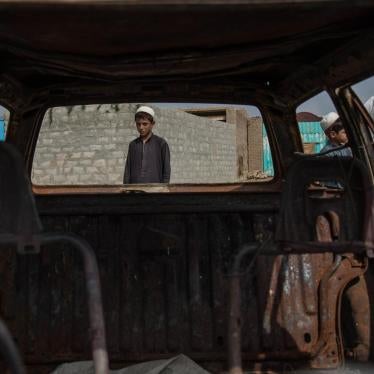After the September 11, 2001 attacks on the United States, the US government authorized the use of so-called “enhanced interrogation techniques” on terrorism suspects in US custody. For years US officials, pointing to Department of Justice memorandums authorizing these techniques, denied that they constituted torture. But many clearly do: International bodies and US courts have repeatedly found that “waterboarding” and other forms of mock execution by asphyxiation constitute torture and are war crimes,[1] Other authorized techniques, including stress positions, hooding during questioning, deprivation of light and auditory stimuli, and use of detainees’ individual phobias (such as fear of dogs) to induce stress, violate the protections afforded all persons in custody – whether combatants or civilians – under the laws of armed conflict and international human rights law, and can amount to torture or "cruel, inhuman, or degrading treatment."[2] Accordingly, the United Nations Committee against Torture and the UN Special Rapporteur on Torture have clearly stated that these techniques are torture.[3]
US President Barack Obama has acknowledged that the US used torture as part of the CIA’s post 9/11 interrogation program, and has said that waterboarding constitutes torture.[4] However, many current and former US officials still argue that the “enhanced interrogation techniques” were not torture.[5] The recent release of the summary of the Senate Intelligence Committee’s report on the CIA’s detention and interrogation program has heightened debate around this issue.
The claims of those who argue these techniques did not constitute torture are contradicted by past US statements criticizing other countries for using those same techniques. Below are some examples of such statements, drawn from the US Department of State’s annual Human Rights Reports.
|
Technique |
Criticized by United States |
Some Examples Used by United States |
|
Waterboarding |
The State Department’s 2003-2007 Human Rights Reports on Sri Lanka classified “near-drowning” as among “methods of torture.” In the reports on Tunisia from 1996 to 2004, “submersion of the head in water” is classified as “torture.”[6] |
The United States government has officially acknowledged waterboarding only three detainees: Khalid Sheikh Mohammed, Abu Zubaydah, and Abd al-Rahim al-Nashiri. Mohammed was waterboarded 183 times, Zubaydah 83 times, and al-Nashiri twice.[7] In Human Rights Watch’s 2012 report Delivered into Enemy Hands, detainee Mohammed Shoroeiya described being repeatedly waterboarded during interrogations in Afghanistan. Another detainee cited in the same report, Sharif, said he was subjected to a similar method of water suffocation where he was made to lie down in a plastic sheet filled with icy water while wearing a hood as jugs of freezing water were poured over his nose and mouth. Their accounts contradict statements about the practice from senior US officials, such as former CIA Director Michael Hayden, who testified to the Senate that the CIA waterboarded only three individuals. Human Rights Watch’s 2011 report Getting Away with Torture details the numerous times US courts found that waterboarding, or variations of it, constitutes torture and is a war crime. Examples include a congressional inquiry of the early 1900s US occupation of the Philippines that led to the court martialing of several US soldiers, and several US military commissions in the World War II Pacific Theater which found that variants of waterboarding constituted torture. |
|
Stress Positions, Forced Standing, Forced Nudity |
The State Department’s 2006 Human Rights Report on Jordan deemed subjecting detainees to “forced standing in painful positions for prolonged periods” as torture.[8] In its 2000, 2001 and 2002 reports on Iran, “suspension for long periods in contorted positions” is described as torture.[9] In the 2002 report on Sri Lanka, “suspension by the wrists or feet in contorted positions” and remaining in “unnatural positions for extended periods” are described as “methods of torture.”[10] In the 2005 report on North Korea, “being forced to kneel or sit immobilized for long periods, being hung by one's wrists, being forced to stand up and sit down to the point of collapse” is classified as a method of torture. The 2005 Egypt reports cited the stripping and blindfolding of prisoners among the “principal methods of torture.”[11] |
According to a report by the International Committee of the Red Cross, some detainees in US custody were subjected to “[p]rolonged stress standing position, naked, held with the arms extended and chained above the head … for periods from two or three days continuously, and for up to two or three months intermittently, during which period toilet access was sometimes denied resulting in allegations from four detainees that they had to defecate and urinate over themselves.” Many of the detainees also described being subjected to extended periods of nudity, ranging from several weeks to several months. In Human Rights Watch’s Delivered into Enemy Hands, five former detainees in CIA custody described being chained to walls naked – sometimes while diapered – in pitch black, windowless cells, for weeks or months; restrained in painful stress positions for long periods; and forced into cramped spaces. As Human Rights Watch detailed in Getting Away with Torture, stress positions were among a number of interrogation and detention techniques authorized for use by the Bush administration. |
|
Threats of Harm to Person, Family |
In the 2006 report on Turkey,“threats to detainees or family members,” and “mock executions” are classified as torture. In the 2006 report on Jordan, “threats of extreme violence or sexual or physical abuse of family members” are deemed as torture. In the 2002 report on Iraq, “threats to rape or otherwise harm family members and relatives” is considered torture. |
According to a 2009 CIA Inspector General’s report, during interrogations a CIA debriefer put an unloaded semi-automatic handgun to detainee Abd al-Rahim al-Nashiri’s head, and also turned a power drill on and off to frighten him while he was naked and hooded. Interrogators also made threats against Nashiri’s family, telling him, “We can get your mother in here,” and, “We can get your family in here.” In the ICRC report Nashiri also alleges that interrogators threatened to sodomize him and rape his family. The CIA report also states that interrogators told Khalid Sheikh Mohammed: “We're going to kill your children.” |
|
Sleep Deprivation, Use of Loud Music |
In the 2005 and 2006 reports on Indonesia, Iran, Jordan, Libya, Saudi Arabia and Turkey, sleep deprivation was classified as torture.[12] In the 2002 State Department report on Pakistan, denial of sleep is described as a “common torture method.”[13] The 2002 report on Turkey lists “loud music” as a “torture method.” |
In Human Rights Watch’s Delivered into Enemy Hands , detainees Mohammed Ahmed Mohammed al-Shoroeiya and Khalid al-Sharif stated that they were denied sleep by continuous, deafeningly loud Western music played from speakers right next to their ears. The ICRC report details various methods used against detainees for sleep deprivation, from the continuous blaring of loud music or hissing noises to long interrogations and stress positions.[14] Abu Zubaydah, also known to have been held by the CIA, claimed that sometimes as he was falling asleep guards would splash water in his face to keep him awake.[15] |
|
Prolonged Solitary Confinement, Confinement in Small Space |
In the 2005 and 2006 reports on Jordan, “extended solitary confinement” is classified as “torture.”[16] The 2002 report on Iraq described “extended solitary confinement in dark and extremely small compartments” as torture. In the 2005 report on North Korea, “being forced to kneel or sit immobilized for long periods, being hung by one's wrists, being forced to stand up and sit down to the point of collapse” is classified as a method of torture. In the 2002 report on China, “prolonged periods of solitary confinement” and “incommunicado detention” are listed as torture. |
The ICRC report describes how detainees were kept in prolonged solitary confinement and incommunicado detention (with no access to family or attorneys) for periods ranging from 16 months to as long as four-and-a-half years. In Delivered into Enemy Hands , detainees describe being held in very small cells for prolonged periods of solitary confinement and incommunicado detention through much of their imprisonment. Getting Away with Torture describes the CIA’s secret detention program as entailing “prolonged incommunicado detention.” |
[1] Human Rights Watch, Getting Away with Torture, July 12, 2011, https://www.hrw.org/sites/default/files/reports/us0711webwcover_1.pdf, p. 55.
[2] Ibid.
[3] Ibid., p. 58.
[4] “Obama: ‘We Tortured Some Folks’ after 9/11,” CBS News, August 1, 2014, http://www.cbsnews.com/news/obama-we-tortured-some-folks-after-911/ (accessed December 5, 2014).
[5] Jose Rodriguez, former chief of the Central Intelligence Agency’s clandestine operations, recently said of the CIA’s enhanced interrogation program for example, that “it worked because it was not torture (“Watching ‘Zero Dark Thirty’ with the CIA: Separating Fact from Fiction,” Moderated Discussion at American Enterprise Institute Transcript, January 29, 2013, http://www.aei.org/wp-content/uploads/2013/01/-event-transcript_111915959376.pdf
(accessed December 5, 2014); Senate Intelligence Committee Vice-Chairman Saxby Chambliss has disputed the use of the term “torture” to describe the CIA’s enhanced interrogation program and said that waterboarding is “not torture, (Sandy Fitzgerald, “Saxby Chambliss: Senate Probe of CIA Interrogations “a Mistake,’” Newsmax August 3, 2014, http://www.newsmax.com/Newsfront/Chambliss-hacking-probe-CIA/2014/08/03/id/586557/ (accessed December 5, 2014); Former US President George W. Bush has also said that “enhanced interrogation techniques” authorized by the Justice Department were legal and that waterboarding is not torture (see “Waterboarding is Torture, Downing Street Confirms,” The Guardian, November 9, 2010, http://www.theguardian.com/world/2010/nov/09/george-bush-memoirs-waterboarding (accessed December 5, 2014).
[6] The Constitution Project, “The Report of The Constitution Project’s Task Force on Detainee Treatment,” 2013, http://detaineetaskforce.org/pdf/Full-Report.pdf (accessed December 2, 2014), p. 359; U.S. Department of State, Human Rights Report, 1996 - 2007, available at http://www.state.gov/g/drl/rls/hrrpt/ (accessed December 2, 2014).
[7] Testimony of Michael Hayden in front of the Senate Select Committee on Intelligence, February 5, 2008, http://www.intelligence.senate.gov/pdfs/110824.pdf, p. 71-72. CIA Office of the Inspector General, “Special Review: Counterterrorism Detention and Interrogation Activities (September 2001 – October 2003),” May 7, 2004, declassified in August 2009, http://graphics8.nytimes.com/packages/pdf/politics/20090825-DETAIN/2004CIAIG.pdf (accessed July 2, 2012), (“CIA OIG report”), p. 90-91.
[8] The Constitution Project, “The Report of The Constitution Project’s Task Force on Detainee Treatment,” p. 359; U.S. Department of State, Human Rights Report, “Jordan,” 2006, http://www.state.gov/j/drl/rls/hrrpt/2006/78855.htm (accessed December 2, 2014).
[9] The Constitution Project, “The Report of The Constitution Project’s Task Force on Detainee Treatment,” p. 359; U.S. Department of State, Human Rights Report, “Iran,” 2000-2002, available at http://www.state.gov/j/drl/rls/hrrpt/2006/78855.htm (accessed December 2, 2014).
[10] The Constitution Project, “The Report of The Constitution Project’s Task Force on Detainee Treatment,” p. 359; U.S. Department of State, Human Rights Report, “Sri Lanka,” 2002, http://www.state.gov/j/drl/rls/hrrpt/2002/18315.htm (accessed December 2, 2014).
[11] Human Rights Watch, “Descriptions of Techniques Allegedly Authorized by the CIA,” November 21, 2005, https://www.hrw.org/legacy/english/docs/2005/11/21/usdom12071_txt.htm; US Department of State, Human Rights Report, “Egypt,” 2005, http://www.state.gov/j/drl/rls/hrrpt/2005/61612.htm (accessed December 2, 2014).
[12] The Constitution Project, “The Report of The Constitution Project’s Task Force on Detainee Treatment,” p. 360; U.S. Department of State, Human Rights Report, 2005-2006, available at http://www.state.gov/g/drl/rls/hrrpt/ (accessed December 2, 2014).
[13] Human Rights Watch, “Descriptions of Techniques Allegedly Authorized by the CIA”; U.S. Department of State, Human Rights Report, “Pakistan,” 2002, http://www.state.gov/j/drl/rls/hrrpt/2002/18314.htm (accessed December 2, 2014).
[14] ICRC, Regional Delegation for United States and Canada, “ICRC Report on the Treatment of Fourteen “High Value Detainees” in CIA Custody,” p. 9, 29.
[15] Ibid., p. 15.
[16] The Constitution Project, “The Report of The Constitution Project’s Task Force on Detainee Treatment,” p. 360; U.S. Department of State, Human Rights Report, “Jordan,” 2005-2006, available at http://www.state.gov/j/drl/rls/hrrpt/ (accessed December 2, 2014).






